Search the Special Collections and Archives Portal
Search Results
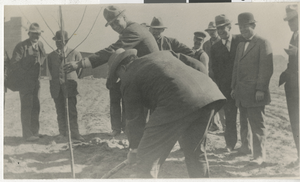
Photograph of people planting first tree in the courthouse park, Las Vegas in March 1911
Date
Archival Collection
Description
Image
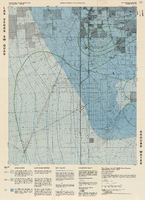
Topographic map of groundwater in the southwest quadrangle of Las Vegas, Nevada, 1985
Date
Description
Text
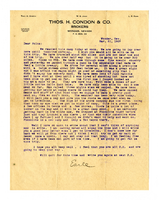
Letter from C. A. Earle Rinker to his family, March 21, 1907
Date
Archival Collection
Description
Text
UNLV Libraries Collection of Gold Strike Resorts Inc. Promotional and Press Materials
Identifier
Abstract
The UNLV Libraries Collection of Gold Strike Resorts Inc. Promotional and Press Materials includes promotional materials, company newsletters, and newspaper clippings for Gold Strike Resorts Inc. located in Jean, Nevada dating from 1986 to 2005.
Archival Collection
Southern Nevada Gem and Mineral Society Records
Identifier
Abstract
The Southern Nevada Gem and Mineral Society Records (1950-2024) contain the records of the Clark County Gem Collectors, Las Vegas Gem Collectors, and the current Southern Nevada Gem and Mineral Society. The collection contains articles of incorporation, by-laws, membership directories, meeting minutes, correspondence, financial records, show paperwork, and award certificates. Also included are photographs of the organizations since the 1970s and digital scans of Gem Times and The Polished Slab newsletters.
Archival Collection
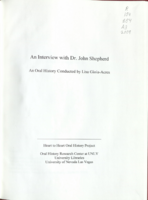
Transcript of interview with Dr. John Shepherd by Lisa Gioia-Acres, November 21, 2008
Date
Archival Collection
Description
Dr. John Richard Shepherd shares the background of his early life in southern Illinois, his father's and grandfather's occupations, and his educational journey through college and medical school. His army experiences in Chicago and Alabama convinced him and his wife to look for a warm dry climate in which to live, and they relocated to Las Vegas in 1968. Dr. Shepherd recalls the businesses and housing surrounding Sunrise Hospital, the difficulties getting his specialty listed in the phone book, and renting his first office space from Nate Adelson. He also describes taking out a loan to install ophthalmology equipment, hiring an office manager with medical accounting experience, and doing cataract surgery in a way that basically hadn't changed for decades. The passing of the Medicare bill back in 1966 caused Dr. Shepherd's practice to build up quickly. He details the many ways eye surgery changed, including the invention of the intraocular lens and the phacoemulsification procedure. He mentions his and Dr. Shearing's contributions to ophthalmology — better designed lenses and surgical techniques - which they taught to other doctors from all over the country. Dr. Shepherd discusses radial keratotomy, which was a precursor to laser and later LASIK surgery, and describes a lens implant technique he learned in Russia from Dr. Fyodorov. He goes on to share anecdotes and stories of his interactions with patients, his travels as a consultant and as a surgical teacher for Project Orbis, and meeting Fidel Castro. He speaks candidly about his successes and his failures as well. Dr. Shepherd retired in 2006 and immediately enrolled in a Master's program and earned a degree in military history. After a long and distinguished career, after receiving many accolades and awards, he and his wife are enjoying life, splitting their time between Sun Valley, Idaho, and Las Vegas.
Text
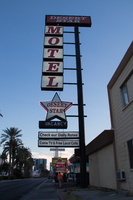
Photographs of Desert Star Motel sign, Las Vegas (Nev.), March 24, 2017
Date
Archival Collection
Description
Site address: 1210 S Las Vegas Blvd
Sign owner: Desert Star Motel Enterprises
Sign details: The original construction of this motel was in 1961 and has acted as a motel since.
Sign condition: 3, sign is in decent condition. Some portions of it do not light up anymore.
Sign form: Roadside pole sign
Sign-specific description: This sign sits directly on the roadside along Las Vegas Boulevard. The sign consists of a large black pole with many different back lit signs extending toward Las Vegas Boulevard attached to it. Staring from the top of the sign. There is a plastic back lit sign reading "DESERT STAR" in bold white letters against a red background. Under this are individual square signs each containing one letter. Moving down the length of the pole they spell out the word "MOTEL". Each of these letters are red against a white background. Under this series of letters is a star shaped back lit sign reading "DESERT STAR" in bold red text against a white background. This sign is outlined by a neon tube that no longer works. Attached to the bottom points of the star is a rectangular back sign with "VACANCY" painted on it in white. Neon tubes outline the word "NO" as well as "VACANCY." Under this sign is another plastic back lit sign reading "Check Out our Weekly & Daily Rates" in white letters against a red background. Finally, the last portion of this sign is another plastic back lit sign reading "Free Local Calls" in white letters against a red background.
Sign - type of display: Neon and back lit plastic sign
Sign - media: Steel and plastic
Sign - non-neon treatments: Plastic backlit sign
Sign environment: This motel sits very close to the intersection of Las Vegas Boulevard and Charleston. It is a short distance away from the Arts District and Fremont Street. It is a few blocks north of the Stratosphere hotel. A few properties that are close to this motel are the Little White Wedding Chapel as well as many other hostels and motels.
Sign - date of redesign/move: From an earlier photograph, this sign has changed from what appears to might have been their original sign. There is no exact year when the sign changed. The sign that they had in the 60s looks similar to their sign today, but with different colors. The earlier sign had the same "MOTEL" running down the side of the pole, but the letters were black against a yellow background and the pole was white. The star under this was white with forest green letters reading "DESERT STAR." There were three other rectangular signs under this. Each of these had forest green letters against a white background. The sign under the star sign and the "NO VACANCY" attached to that read " TV PHONES." The second sign said "REFRIGERATION." And the third said "AAA HEATED POOL."
Sign - thematic influences: The name "DESERT STAR" could've taken influence from the Space Age. There were plenty of motels that had a star theme or "star" in their name all throughout the city.
Sign - artistic significance: This is a good example of how roadside signs could be simple, yet eye catching to motorists and pedestrians. It does keep in theme with many of the other motel signs throughout the city by sitting directly along the roadside to be noticeable.
Survey - research locations: Assessor's Page, Stephani Drives Las Vegas Website http://stefanidrivesvegas.com/8.html
Survey - research notes: There in not much information on the history of this property.
Surveyor: Emily Fellmer
Survey - date completed: 2017-09-09
Sign keywords: Neon; Plastic; Backlit; Steel; Roadside; Pole sign
Mixed Content
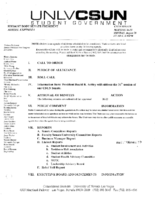
Meeting minutes for Consolidated Student Senate, University of Nevada, Las Vegas, August 28, 2006
Date
Archival Collection
Description
Text

Letters from the Jewish Family Service Agency requesting financial aid from the Jewish Federation Foundation, February 1989
Date
Archival Collection
Description
Rough-draft versions of letters written by William Feldman, Executive Director of the Jewish Family Service Agency (JFSA), and Barry D. Eisen, President of the Jewish Family Service Agency, to Norman Kaufman, Executive Director of the Jewish Federation, and Paul Eisenberg, Chairman of the Endowment Committee, requesting financial aid from the Jewish Federation Foundation endowment fund to support the Jewish Family Service Agency's Elderly Services program. (Original order of pages is unclear, some pages may have been lost prior to donation.)
Text

